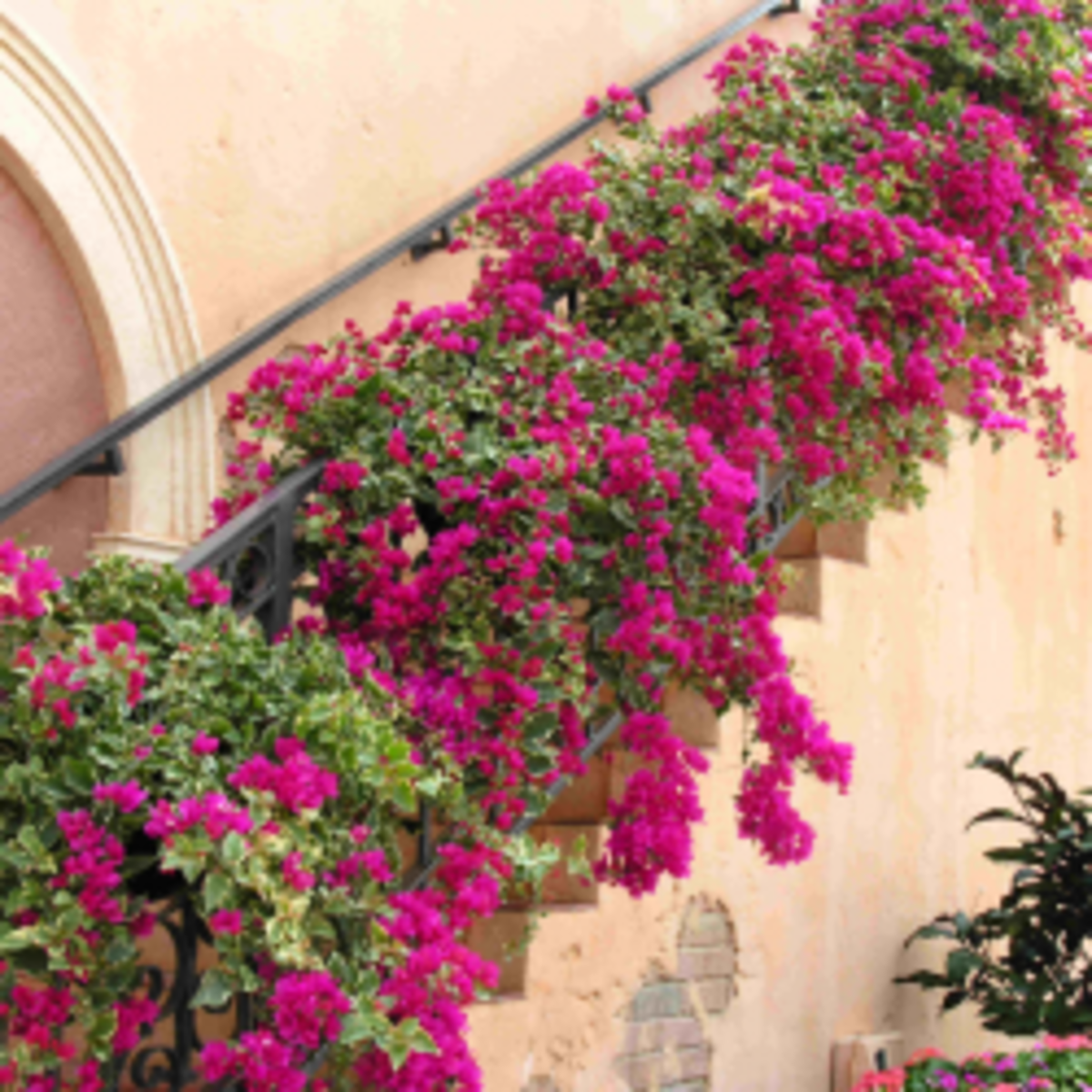What Is Hydroponics?
THE term soil less culture is synonymously used in Hydroponic technology. The word means ‘the working water'.
In other words, the cultivation of plants in water is referred as hydroponics. However in a broader sense, the cultivation of crops in any growing substrates, whether organic that is, peat moss, coconut fibre, straw bales, grapes residue, etc. or inorganic perlite, vermiculite, rockwool, sand etc., in the absence of soil is referred to as Hydroponics.This idea is not new; rather it is as old as Babylonian hanging gardens, which was probably one of the first attempts to grow plants without soil during the era of B.C. Similarly, the floating gardens of the Aztecs of Mexico and those of the Chinese, as described by Marco Polo in his famous journal, were, in a sense, also Hydroponics.Later on, with the passage of time, the collection of experimental evidences has proved the use of hydroponics as an optimum potential of plant growth. However, on commercial basis, hydroponics is being practiced for few decades and can be counted as young and dynamic technique of commercial plant cultivation.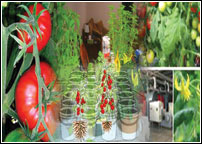
Hydroponics around the world
The dynamic era of hydroponics (substrate culture), probably started in 1973 when the Danish Rockwool-Industry publicised their hydrophilic GRODAN-rockwool as a horticultural substrate. In the meantime, the substrate culture with its more than 60pc of the glasshouse acreage in the Netherlands and 50pc in Belgium and France has become the most important growing technique. In Spain, during the years of 1992 and 93, the estimated 800 ha of crops were cultivated under hydroponics.
Turkey is ranked fourth in the world with respect to the total area of greenhouses and is a world-wide tomato producing country with the production over 6,300,000 tonnes per year, out of which 1,500,000 tonnes is used for industrial processes such as tomato paste, peeled and diced tomato and sun-dried tomatoes.
In The Netherlands, the area of hydroponics production in 1992 was estimated at 3760 ha, including tomato on a total area of 1506 ha, out of which 92 per cent was used for hydroponics under glass. Each year the share of soil cultivation lessens and the aim is to reach 100 per cent of the area in a closed soilless culture system which is almost achieved. With tomato and cucumbers the Dutch agribusiness has built up a strong position on the West European market for fresh vegetables. From 1990 onward, Spain has increased the export especially, tomatoes. More than half of the vegetable growers in New Zealand have moved to hydroponics over the past 15-20 years.
At present in Sardinia, Italy there are over 60,000 m2 dedicated to the cultivation of tomatoes on grapes marc and this figure is expected to be widened further. It is believed that the low cost and availability of the substrate, the high unit yield and economic convenience of cultures will determine a great expansion of growth system, especially in areas of South Italy which are particularly dedicated to the cultivation of tomatoes in glasshouse. In recent five years, China has developed systems such as Eco-organic type soilless culture that includes; coal cinder, peat moss, vermiculite, coir, sawdust, perlite, sand, rice husk etc. they are used by mixing with organic fertiliser. They are also low in cost and are more suitable for the local condition.
Various parts of the coconut palm like the coconut husk, fibre from the husk, wood chips from the trunk and dried fronds have been used as growing media to raise many greenhouse crops. Coconut fibre is especially regarded excellent for high yields of tomato and other crops. The inorganic substrate, polyurethane ether foam (PUR) that was commercialised in 1986, has now acquired a worldwide renown. In large scale growing, so far, positive results were experienced with tomato on seven-year-old PUR-mats.
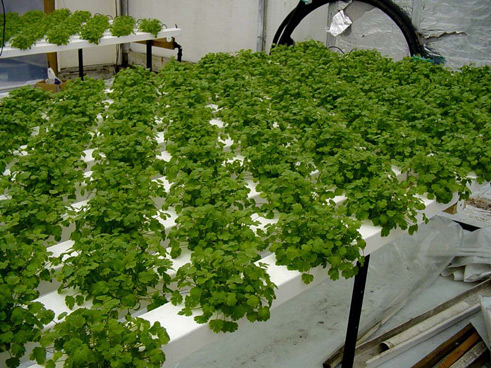
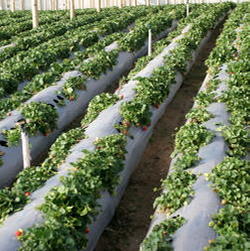
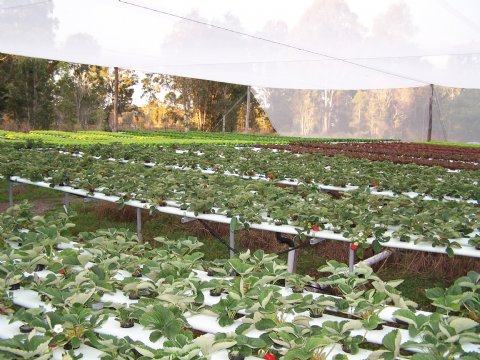
Brief mode of Hydroponics
The greenhouse structures are based on the available sources as the capital investment. These structures are constructed to control the growing climatic condition mainly including light, temperature, air circulation, humidity etc. for proper growth and development of the crops. The structures should be erected in such a manner that optimum advantage should be taken from the prevalent seasonal weather conditions. The direction of greenhouse is also important factor to make use of better crop production by consuming the sunshine entering into the structure from a certain direction. The structures are designed with a specific shape, viz. raised cutters and screen of green net is usually introduced to give shade to the plants during scorching heat or when the plants need less light for the proper growth.
The rainwater consumed for crop production can efficiently be collected in the form of reservoir and this idea has negated the claim that Hydroponic crop production need surplus water. Rather this technique drastically saves the water and is a potential and practical application of modern but well established technique for getting higher and quality yield of a number of crops. The rainwater falling in the surrounding area and dropped through the raised cutters of greenhouses are collected into the channels constructed nearby and is ultimately accumulated in the reservoirs.
It should be kept in mind that if circumstances do not permit for water harvesting through such reservoirs, even then a limited amount of water could serve the purpose to canalise the production routine. In many a countries of the world, the drainage water after proper treatment based on latest technology, enables the water to be reused for crop production. The arrangement of irrigation can be manipulated by applying mist system; drip irrigation and also the controlled cooling pad system to maintain the requisite humidity in the greenhouse. In greenhouse production, the introduction of supplemental CO2 inside the plant growing environment is made to enhance the crop growth. The logical reasoning of CO2 that plants use this gas to manufacture their food under the action of a biological process called photosynthesis.
The sources of plant nutrients (salts) for macro (nitrogen, phosphorus, potassium, calcium, magnesium, etc.) and micro (zinc, sulphur, iron, cupper, molybdenum, manganese, etc.) elements are acquired from the reliable source. A suitable air system has to be installed to regulate the heating and cooling in accordance with the temperature requirement of the crop schedule. This is heavily practiced in most of the greenhouses.
However, in the areas where energy crises prevail and the fuel cost is hard to bear, in such instances cold glasshouses (unheated glasshouses) are undertaken for production objective. And the use of energy for the sustainability of temperature inside the greenhouses is to the level at critical stage when temperature either very low or very high to operate the heating or cooling system. This kind of exercise is done to overcome the critical moments in plants to avoid the risk of high mortality under adverse climatic conditions. Some of the climatic components are automated with the help of computer and are very common and cost effective when compared with the manual routine where the labour charges come out exorbitant.
In advanced countries, every component of greenhouse system is directly attached with the computer control, thus has been monitored in the office. Any fault in any part of the system in the greenhouse can certainly be identified instantly to rectify the problem within no time. As an example, the flow of feed provided to the plants in the greenhouse can give clear-cut indications for the level of pH, EC, amount of micro and macronutrients etc. If any interruption appears in the smooth channelling of the solution flow, it will be localised through computer screen, and the concerned individual will remove the choking thus maintains the flow in the channel.
The crops grown by hydroponics have a sizable volume of market within the country and a lot of prospects that have been explored to export the crop like tomato, lettuce, strawberry, cut flowers etc. For example, tomato is grown in thousand tonnes of volume around the world moreover different types of tomatoes including beefsteak, cluster, cherry etc. are produced by hydroponics. The seeds must be hybrid in nature to get the optimum yield. The crop can be obtained round the year without any break followed by a strict schedule.
Needless to say that introducing the hydroponics greenhouse production in developing agricultural countries will raise the future column and can give a boost to such productive technologies and there economies.


